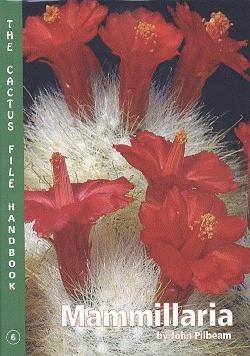There are quite a number of Mammillaria books that have been published in the past; Craig, Marsden, John Pilbeam's previous book, Reppenhagen not to speak of three specialist journals and substantial contributions in Bradleya, Britton & Rose and Backeberg. There are however serious drawbacks to many of these works - the best technical treatments are rather out of date and don't cover recent discoveries, whilst some of the more recent publications are either somewhat eccentric or perhaps confine themselves to strictly taxonomic matters.
John's 'magnum opus' - it cannot be called anything less effectively supersedes all these previous works and produces I believe in a single volume a work which I think very possibly will please both horticulturalists and taxonomists. Such a squaring of the circle I would have scarcely believed possible. The fact that Mammillarias are John's first love and that he has been studying and researching them for so long clearly comes through in the book. I cannot claim to have yet read the book from cover to cover, although I have read quite large sections of it. For what is intended as a serious reference book it is immensely readable with all sorts of insights and snippets of information included.
The technical production of the book is to the high standard we have come to expect of Cirio and includes many photographs, some of exceptional quality, the vast majority of a very good standard and just a few that are a little below par. This is always a problem for a publication which is trying to illustrate all species because for some no high quality images are available and this is a relatively minor quibble.
The vast majority of the book is taken up with a commentary on the species, many of which are not only illustrated as cultivated specimens but also in habitat. Seeing these photographs together is very interesting. Each species is also accompanied by distribution maps. These graphics are much more informative than a simple list of states which all previous Mammillaria works have used and are well worth the long hours that it took to put these together.
I am not going to comment in detail on the classification issues as I am not really qualified to do so not being a Mammillaria specialist. It is sufficient to say the following the lead of Desmond Cole in his work on Lithops, John has made extensive use of the category of sub-species, an idea I beleive first propounded for mammillarias by Dr David Hunt. I think this has worked very well, as it has retained the information about the plants that the horticulturalists want to grow, while simultaneously satisfying the taxonomists needs for defining the relationships between plants.
There are some very nice sections at the end of the book which collectors will find very useful. Additional photographs in 'Variations of Merit' illustrate forms, hybrids etc not otherwise covered in the body of the commentary. A very useful section on superfluous names and synonyms refers you to the accepted name in the book. There is an extensive listing of field collection numbers including those of Lau, Reppenhagen, Lacoste, Brack, Minnich all of whom have collected significant numbers of Mammillarias. A bibliography is also included.
If you have anything more than a passing interest in Mammillarias then this book is essential for you. I am sure it will stand as the standard work on the subject for some considerable time.


